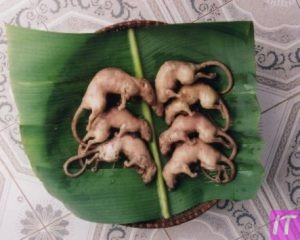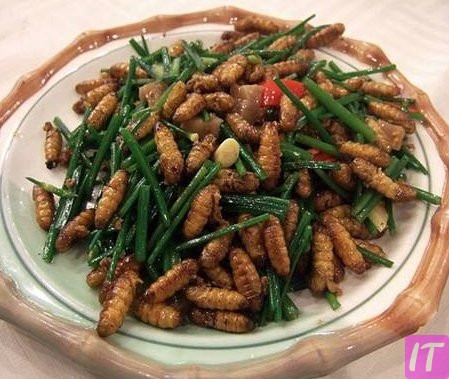Ever been curious why animal intestines or century-old eggs make their way to Chinese dining tables, often eliciting reactions of disgust from Western palates? Perhaps it’s not so much about the taste but rather the rich cultural traditions that underpin these dishes. In fact, many of these so-called “disgusting foods” are celebrated delicacies linked to historical practices.
The appetite for what might appear unappealing to some is deeply rooted in Chinese history and resourcefulness. During times of scarcity, nothing was wasted, leading to innovative culinary practices acclaimed for their nutritional value. For instance, a 2015 food study noted that 80% of the world’s population consumes insects regularly, highlighting regional differences in dietary norms.
Why do the Chinese eat the most disgusting foods?
Food that seems disgusting to one culture can be a delicacy to another. In China, foods like chicken feet and century eggs are considered not only delicious but also nutritious. Many of these dishes reflect China’s long history. People had to be resourceful during tough times, and nothing could go to waste. Over time, these foods became part of the culinary tradition.
Cultural differences heavily influence what we consider to be disgusting. Western cultures may find some Chinese foods off-putting simply because they are unfamiliar. For example, stinky tofu has a strong smell but is loved by many in China. Different textures and flavors can also seem strange to those not used to them. It’s all about what people grow up eating.
These unique dishes often carry health benefits that aren’t immediately obvious. Chicken feet are packed with collagen, which is great for skin and joints. Jellyfish salad is low in calories and high in protein. By eating a wide variety of foods, people can take in many different nutrients. Some ingredients used in Chinese cuisine are even believed to have medicinal properties.
Trying new foods can broaden one’s culinary horizons. While some dishes might initially seem intimidating, they often have rich, interesting flavors. The next time you see something unusual on a Chinese menu, give it a try. You might discover a new favorite dish. Plus, you’ll gain a deeper appreciation for a different culture.
Defining “disgusting”: Cultural differences in tastes
What one culture finds appetizing, another might find disgusting. Take durian, for example; known as the “king of fruits” in Southeast Asia, it has a strong odor that many Westerners can’t stand. Yet, it’s a beloved fruit in countries like Thailand and Malaysia. These cultural differences shape our perceptions of what is edible or tasty. It’s all about what we’re used to.
In many Western countries, insects are seen as pests. However, in parts of Africa and Latin America, insects like crickets and grasshoppers are standard snacks. They are crunchy, tasty, and packed with protein. This isn’t limited to insects; a list of foods might include blood sausage and haggis, both delicacies in parts of Europe.
The idea of “disgusting” food often stems from unfamiliarity. If you didn’t grow up eating something, it might seem strange or gross at first. For example, many Americans are put off by the thought of eating frogs’ legs, though they are relished in French cuisine. Over time, trying these foods can broaden your palate.
Cultural foods often carry significant meaning. They can be linked to traditions, celebrations, or even survival. Traditional Chinese dishes like bird’s nest soup have been consumed for centuries due to their supposed health benefits. By understanding the cultural context, seemingly “disgusting” foods begin to make more sense.
The role of history and survival in Chinese culinary choices
Centuries of history have shaped Chinese culinary practices. During times of famine or scarcity, the Chinese had to maximize every available resource. This meant finding ways to make every part of an animal or plant edible. Dishes that might seem unusual today were born out of necessity. This ingenuity turned survival food into beloved staples.
The Ming and Qing dynasties played significant roles in molding Chinese cuisine. Imperial chefs were known for their ability to craft elaborate meals from simple ingredients. Over time, these practices trickled down to common folk, affecting everyday meals. Even simple ingredients became part of complex recipes. Thus, what started as necessity evolved into cultural traditions.
Famines pushed people to be highly resourceful. In the 20th century, the Great Chinese Famine forced people to eat anything available, including bark and wild plants. Such experiences left an indelible mark on the country’s food culture. These survival tactics turned into culinary practices passed down through generations.
Both urban and rural areas contributed unique cooking methods and ingredients. Coastal regions relied heavily on seafood, while inland areas used whatever was available. Traditional methods like fermenting and pickling helped preserve food. This preservation technique added new flavors and textures, enriching the culinary landscape.
Chinese delicacies: Unusual foods that are considered a treat in China
Chinese cuisine features a variety of dishes considered unusual by Western standards, yet many are highly prized delicacies. Century eggs, also known as preserved eggs, are a notable example. These eggs are fermented for several weeks to months in a mixture of clay, ash, and quicklime. Though their look and smell can be off-putting, their creamy texture and unique flavor are beloved by many in China.
Another famous delicacy is Bird’s Nest Soup, made from the nests of swiftlets. The nests are created from the bird’s saliva and are rich in nutrients. This soup is often reserved for special occasions due to its rarity and high cost. It’s believed to have numerous health benefits, including boosting the immune system and improving skin tone.
Chicken feet, often referred to as “phoenix claws,” are another treat enjoyed in China. They are typically marinated and then steamed or fried. The texture is gelatinous, and they are packed with collagen. Though it might seem odd to eat feet, they are a common snack or part of a larger meal in various Chinese regions.
Stinky tofu is another notable dish, particularly in street markets. This fermented tofu has a strong odor but is crispy on the outside and soft inside. Despite its smell, its flavor is quite mild and loved by many. It’s a popular snack, especially at night markets.
Jellyfish salad is another unusual yet popular dish. Jellyfish is soaked in water and then sliced into thin strips. It has a crunchy texture and is usually served with a tangy, spicy dressing. This dish is especially popular during summer as it’s refreshingly light and cool.
Lastly, there’s the sea cucumber, esteemed for its texture and health benefits. Often found in soups and stews, sea cucumbers are thought to boost immunity and improve joint health. They are particularly popular in coastal regions. Their mild flavor allows them to absorb the flavors of the dishes they are cooked in.
Nutrition and health benefits of often stigmatized Chinese dishes
Many Chinese dishes that seem unusual contain high nutritional value. Century eggs, for instance, are rich in protein and low in fat. They also provide essential minerals like iron and selenium. Despite their strong taste, they can be a healthy addition to one’s diet. These eggs are also known to aid digestion.
Chicken feet, or “phoenix claws,” are another nutritious option. They are an excellent source of collagen, which is beneficial for skin and joint health. The collagen content helps improve skin elasticity and reduces joint pain. These benefits make chicken feet more than just a snack. They are also low in calories, making them a healthy treat.
Many people might steer clear of stinky tofu, yet it has notable health benefits. This fermented food is packed with probiotics, which are good for gut health. Probiotics help maintain a healthy balance of bacteria in the intestines. This, in turn, boosts the immune system. Regular consumption can also aid digestion and nutrient absorption.
Bird’s Nest Soup is another dish lauded for its health properties. Rich in protein and amino acids, it’s considered a tonic food. It’s believed to help with recovery and boost the immune system. Additionally, the nutrients in bird’s nest are said to improve skin texture. Its high nutritional content makes it a luxurious health food.
Jellyfish salad, often seen as an exotic dish, is incredibly nutritious. Jellyfish is low in calories and high in protein. It also provides significant amounts of collagen, which can benefit the skin. The crunchy texture is enjoyable and unique. It’s a great option for those seeking a low-calorie, high-protein meal.
Sea cucumbers are another unusual but healthy food. They are low in fat and an excellent source of protein. They also contain important vitamins and minerals, like vitamin A and magnesium. Many believe sea cucumbers have anti-inflammatory properties. These benefits make them a nutritious addition to various dishes.

Broadening our culinary horizons: How to appreciate “disgusting” foods
Trying foods that seem disgusting at first glance can be an eye-opening experience. It’s essential to approach these dishes with an open mind. Start by learning about the cultural significance and ingredients of the dish. Understanding the history behind a dish can make it more interesting and appealing. Often, it’s the story that adds flavor to the meal.
One way to ease into new culinary experiences is by starting with smaller portions. A small bite can be much less intimidating than a whole plate. Share these dishes with friends who are also curious or adventurous. This makes the experience more enjoyable. Plus, sharing food can foster a sense of community and open discussions about cultural differences.
Experiment with different ways of preparing the food. For example, stinky tofu can be deep-fried, steamed, or grilled. Each method offers a unique taste and texture. Some people prefer one method over another, so don’t be discouraged if you don’t like it the first time. Experimentation is a big part of broadening your culinary horizons.
Pairing unusual foods with familiar ones can also help. Consider having century eggs with congee, a simple rice porridge commonly eaten in China. The familiarity of the congee can balance out the strong flavor of the century eggs. This makes the experience less overwhelming and more enjoyable. Trying foods this way can make them feel less intimidating.
Traveling can greatly enhance your appreciation for diverse foods. Visiting countries where these dishes are popular allows you to experience them in their original context. Often, dishes taste different when prepared authentically. Traveling also immerses you in the culture, helping you understand why the food is valued. Experiencing food this way can be life-changing.
Finally, read reviews or watch videos of others trying these foods. Knowing that others have enjoyed these dishes can boost your confidence. It can also provide tips on how to best enjoy the food. Reviews and videos often include helpful advice and honest reactions. This can serve as a guide for your own culinary adventure.
Frequently Asked Questions
Diving into the reasons behind the consumption of foods deemed unusual by Western standards, these FAQs explore cultural, historical, and nutritional insights. Read on to uncover the fascinating aspects of Chinese culinary choices.
1. What are some common “disgusting” foods in China?
Common dishes that might seem unusual include century eggs, stinky tofu, and chicken feet. Century eggs are preserved for weeks or months, resulting in a strong taste appreciated by many locals. Stinky tofu has a powerful odor but is popular as a street food snack.
Chicken feet, often referred to as “phoenix claws,” are marinated, steamed or fried. These dishes may appear unappetizing but are loved for their unique textures and flavors. Such foods also hold historical significance and carry various health benefits.
2. Are there nutritional benefits to eating these unusual foods?
Yes, many of these foods offer significant nutritional benefits despite their unfamiliar appearances. For example, chicken feet are rich in collagen, which promotes skin elasticity and joint health.
Century eggs provide essential minerals such as iron and selenium while being low in fat. Stinky tofu is packed with probiotics that support gut health and the immune system.
3. Do Chinese people eat such foods regularly?
The frequency varies depending on the region and personal preferences. While some delicacies like bird’s nest soup are reserved for special occasions due to their high cost and rarity.
Daily meals might include items like jellyfish salad or chicken feet more often because they are easier to obtain and prepare. The inclusion of these foods showcases culinary diversity across different Chinese regions.
4. How do cultural differences affect food perceptions?
Cultural upbringing heavily influences what we perceive as palatable or disgusting. Foods that one culture finds unappealing can be traditional favorites in another part of the world.
This disparity arises from differing tastes developed over generations. Understanding cultural context helps broaden our appreciation for diverse cuisines like those found in China.
5. Can trying these foods broaden one’s palate?
Absolutely! Venturing beyond familiar tastes can open up new culinary experiences and broaden one’s palate. Trying small portions first can make the process less intimidating.
The more you try new dishes, the more you understand different flavors and textures around the world. This approach also fosters greater cultural appreciation along with expanding your taste horizons.
Conclusion
Understanding why the Chinese eat foods deemed “disgusting” requires a deeper look into cultural and historical contexts. These foods often have long-standing traditions and nutritional benefits, turning what might seem unappealing to some into culinary treasures for others. Broadening our horizons fosters appreciation for diverse eating habits.
Exploring these unique foods can be a rewarding journey, offering both new flavors and insights into Chinese culture. Embracing diversity in cuisine leads to a richer, more inclusive world and expands our palates. Next time you encounter an unusual dish, remember, it’s a taste of history and culture on your plate.







